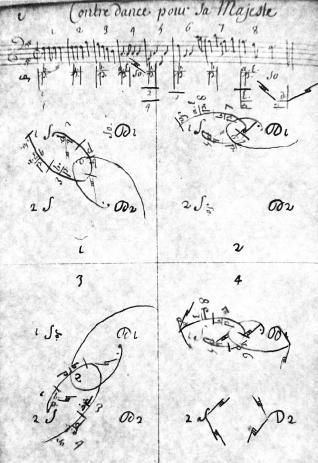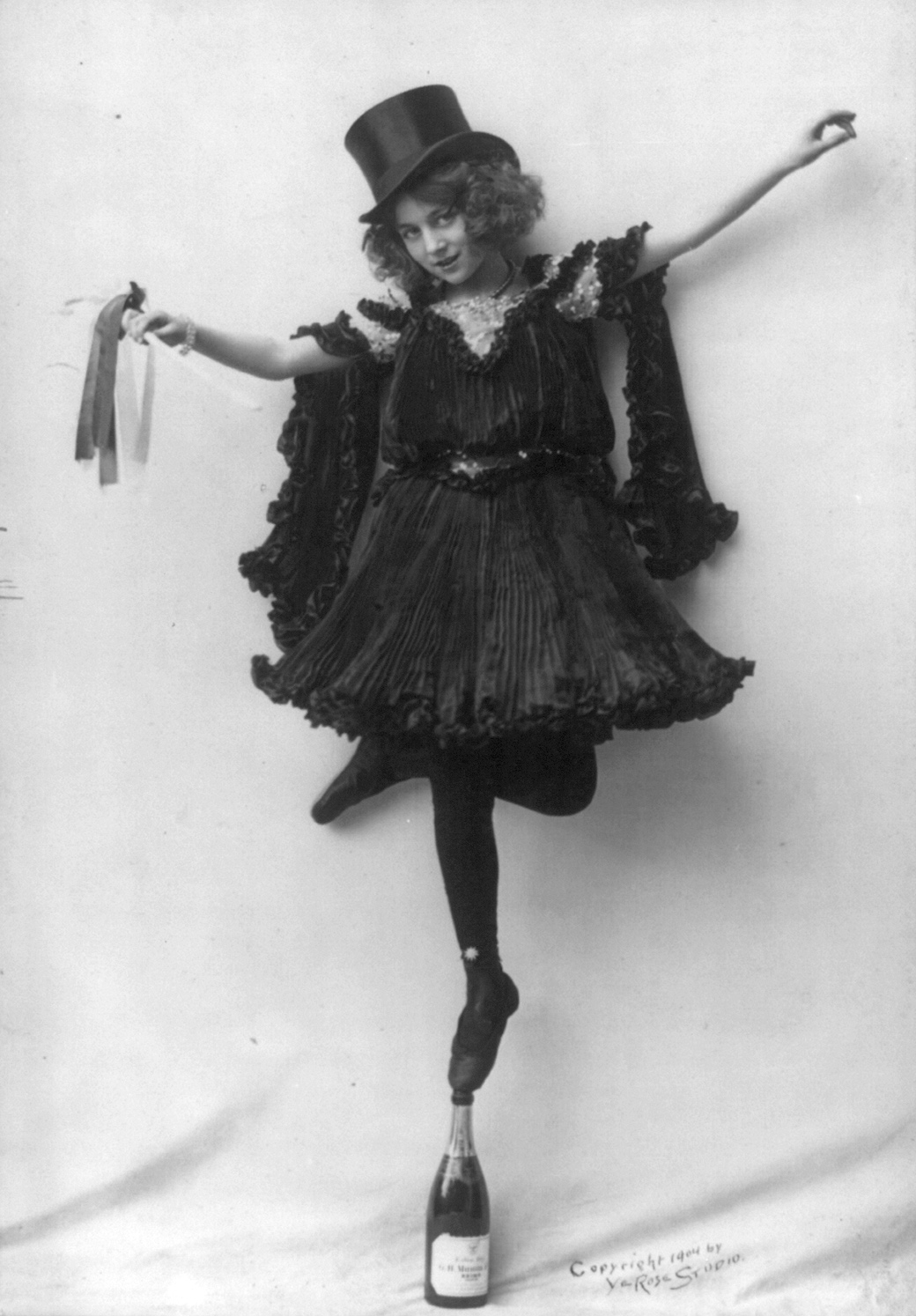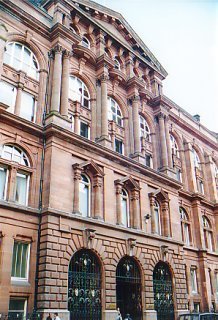|
Scottish Country Dancing (Source)
Scottish country dance (SCD) is the distinctively Scottish form of country dance, itself a form of social dance involving groups of couples of dancers tracing progressive patterns. A dance consists of a sequence of figures. These dances are set to musical forms (Jigs, Reels and Strathspey Reels) which come from the Gaelic tradition of Highland Scotland, as do the steps used in performing the dances. Traditionally a figure corresponds to an eight-bar phrase of music. Country dancing, which is arguably a type of folk dancing, first appears in the historical record in 17th-century England. Scottish country dancing as we know it today has its roots in an 18th-century fusion of (English) country dance formations with Highland music and footwork. It has become the national ballroom dance form of Scotland, partly because "Caledonian Country Dances" became popular in upper-class London society in the decades after the Jacobite rising of 1745. As early as 1724 there was a published c ... [...More Info...] [...Related Items...] OR: [Wikipedia] [Google] [Baidu] |
Fugue
In music, a fugue () is a contrapuntal compositional technique in two or more voices, built on a subject (a musical theme) that is introduced at the beginning in imitation (repetition at different pitches) and which recurs frequently in the course of the composition. It is not to be confused with a ''fuguing tune'', which is a style of song popularized by and mostly limited to early American (i.e. shape note or "Sacred Harp") music and West Gallery music. A fugue usually has three main sections: an exposition, a development and a final entry that contains the return of the subject in the fugue's tonic key. Some fugues have a recapitulation. In the Middle Ages, the term was widely used to denote any works in canonic style; by the Renaissance, it had come to denote specifically imitative works. Since the 17th century, the term ''fugue'' has described what is commonly regarded as the most fully developed procedure of imitative counterpoint. Most fugues open with a short ma ... [...More Info...] [...Related Items...] OR: [Wikipedia] [Google] [Baidu] |
Ghillies (dance)
Ghillies are specially designed shoes used for several types of dance. They are soft shoes, similar to ballet shoes. They are used by women in Irish dance, by men and women in Scottish country dance, and by men and women in Highland dance. Ghillies are also sometimes known by a variety of other names that include: light shoes, pomps, pumps, and soft shoes. Appearance and materials Ghillies are soft shoes, almost always made of a supple leather that forms to the foot. They use laces which criss-cross the top of the foot and are tied together similar to a sneaker. Most dancers use laces (required in competitions), although some ghillies do utilize elastic. Some dancers will also wrap the laces/elastics around the soles of the feet. The soles usually stretch across the entire bottom of the shoe (full-soled) and are made from leather. Some ghillies, however, are split-soled, with a leather sole under the heel and under the ball of the foot. Ghillies are most commonly black, alt ... [...More Info...] [...Related Items...] OR: [Wikipedia] [Google] [Baidu] |
Dirk Dance
A dirk dance is a Scottish dance performed while brandishing a dirk. It is a solo dance but can be performed by two or more people dancing in unison. The dance is quite different in style from the better known Highland dances and in many ways imitates the use of a dirk in fighting. Research suggests that the dance may, in fact, have originated as a series of moves for training in the use of the dirk. There are records showing that a Dirk Dance was included in Highland Dance competitions in 1841.Webster, David, Scottish Highland Games, 1959 ed., pg.33 The dance was recorded by J. F. and T. M. Flett in their book, ''Traditional Step-Dancing in Scotland'', after they learned it from Mary Isdale Mac Nab of Vancouver. She in turn had learned the dance in the 1900s from Scottish piping and dance champion, D.C. Mather. Another tradition of dirk dance, now lost, involved two dancers. In this dance, one is "killed" with the dirk, but then resurrected by his/her sorrowful partner. A dirk d ... [...More Info...] [...Related Items...] OR: [Wikipedia] [Google] [Baidu] |
Four Scottish Dances
''Four Scottish Dances'' ( Op.59) is an orchestral set of light music pieces composed by Malcolm Arnold in 1957 for the BBC Light Music Festival. The dances Arnold's set, or suite, consists of four dances inspired by, although not based on, Scottish country folk tunes and dances. Although the individual dances are not titled, each is denoted by a separate tempo or style marking. The composer's notations in the score, including his metronome indications ( M.M.), are: * I. ''Pesante'' (♩ = 104) * II. ''Vivace'' (♩ = 160) * III. ''Allegretto'' (♩ = 96) * IV. ''Con brio'' (♩ = 144) While Arnold did not title the four pieces individually, his music publisher (Novello & Co) has provided notes, which are often employed by annotators for orchestral and concert programs. The first dance, Novello observes, is "in the style of a strathspey"; the second, a "lively reel." The song-like and graceful third dance evokes "a calm summer's day in the Hebrides"; while the last is "a li ... [...More Info...] [...Related Items...] OR: [Wikipedia] [Google] [Baidu] |
English Country Dance
A country dance is any of a very large number of social dances of a type that originated in the British Isles; it is the repeated execution of a predefined sequence of figures, carefully designed to fit a fixed length of music, performed by a group of people, usually in couples, in one or more sets. The figures involve interaction with your partner and/or with other dancers, usually with a progression so that you dance with everyone in your set. It is common in modern times to have a "caller" who teaches the dance and then calls the figures as you dance. Country dances are done in many different styles. As a musical form written in or time, the contredanse was used by Beethoven and Mozart. Introduced to South America by French immigrants, Country Dance had great influence upon Latin American music as contradanza. The ''Anglais'' (from the French word meaning "English") or ''Angloise'' is another term for the English country dance. A Scottish country dance may be termed an . ... [...More Info...] [...Related Items...] OR: [Wikipedia] [Google] [Baidu] |
List Of Scottish Country Dances
There are more than 15,000 documented Scottish country dances; only the most frequently danced or otherwise notable ones are listed here. Dances are marked with the music and dance styles used: R8×32 3C/4 means a Reel of 32 bars repeated 8 times for 3 couples in a set of 4 couples in a longwise set. The letters for the music styles are: R reel; J jig; P polka; S strathspey; W waltz. * Anniversary Reel – R4×32 4C set – Sheila Muir 1987 * Awa', Whigs, Awa' (R8x32) 3C (4C set) Hugh Foss Dances to Song Tunes * The Bees of Maggieknockater – J4×32 4C set – John Drewry 1975 * The Belle of Bon Accord – S4×32 4C set – John Drewry 1981 * Blooms of Bon Accord – R4×32 4C set – John Drewry 1971 * Bratach Bana – J8x32 3C/4 – John Drewry 1964 * Clutha – R4×48 Square set – unknown 1890 *Canadian Barn Dance - *Dashing White Sergeant – 32 bar reel 3 facing 3 round the room – unknown * The De'il Amang the Tailors – R8×32 3C/4 – unknown * The Dream C ... [...More Info...] [...Related Items...] OR: [Wikipedia] [Google] [Baidu] |
Balance (ability)
Balance in biomechanics, is an ability to maintain the line of gravity (vertical line from centre of mass) of a body within the base of support with minimal postural sway. Sway is the horizontal movement of the centre of gravity even when a person is standing still. A certain amount of sway is essential and inevitable due to small perturbations within the body (e.g., breathing, shifting body weight from one foot to the other or from forefoot to rearfoot) or from external triggers (e.g., visual distortions, floor translations). An increase in sway is not necessarily an indicator of dysfunctional balance so much as it is an indicator of decreased sensorimotor control. Maintaining balance Maintaining balance requires coordination of input from multiple sensory systems including the vestibular, somatosensory, and visual systems. * Vestibular system: sense organs that regulate equilibrium (equilibrioception); directional information as it relates to head position (internal gravitation ... [...More Info...] [...Related Items...] OR: [Wikipedia] [Google] [Baidu] |
University Of Strathclyde
The University of Strathclyde ( gd, Oilthigh Shrath Chluaidh) is a public research university located in Glasgow, Scotland. Founded in 1796 as the Andersonian Institute, it is Glasgow's second-oldest university, having received its royal charter in 1964 as the first technological university in the United Kingdom. Taking its name from the historic Kingdom of Strathclyde, it is Scotland's third-largest university by number of students, with students and staff from over 100 countries. The institution was named University of the Year 2012 by Times Higher Education and again in 2019, becoming the first university to receive this award twice. The annual income of the institution for 2019–20 was £334.8 million of which £81.2 million was from research grants and contracts, with an expenditure of £298.8 million.. History The university was founded in 1796 through the will of John Anderson, professor of Natural Philosophy at the University of Glasgow, who left i ... [...More Info...] [...Related Items...] OR: [Wikipedia] [Google] [Baidu] |
Physical Fitness
Physical fitness is a state of health and well-being and, more specifically, the ability to perform aspects of Outline of sports, sports, occupations and daily activities. Physical fitness is generally achieved through proper nutrition, moderate-vigorous physical exercise, and sufficient rest along with a formal recovery plan. Before the Industrial Revolution, fitness was defined as the capacity to carry out the day's activities without undue fatigue or lethargy. However, with automation and changes in lifestyles, physical fitness is now considered a measure of the body's ability to function efficiently and effectively in work and leisure activities, to be healthy, to resist hypokinetic diseases, improve immune system and to meet emergency situations. Overview Fitness is defined as the quality or state of being fit and healthy. Around 1950, perhaps consistent with the Industrial Revolution and the treatise of World War II, the term "fitness" increased in western vernacular by ... [...More Info...] [...Related Items...] OR: [Wikipedia] [Google] [Baidu] |
Swing Dance
Swing dance is a group of social dances that developed with the swing style of jazz music in the 1920s–1940s, with the origins of each dance predating the popular "swing era". Hundreds of styles of swing dancing were developed; those that have survived beyond that era include Lindy Hop, Balboa, Collegiate Shag, and Charleston. Today, the best-known of these dances is the Lindy Hop, which originated in Harlem in the early 1930s. While the majority of swing dances began in African American communities as vernacular African American dances, some influenced swing-era dances, like Balboa, developed outside of these communities. "Swing dance" was not commonly used to identify a group of dances until the latter half of the 20th century. Historically, the term "Swing" referred to the style of jazz music, which inspired the evolution of the dance. Jitterbug is any form of swing dance, though it is often used as a synonym for the six-count derivative of Lindy Hop called "East Coast ... [...More Info...] [...Related Items...] OR: [Wikipedia] [Google] [Baidu] |





